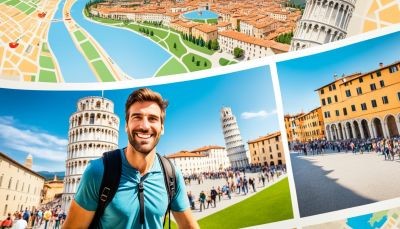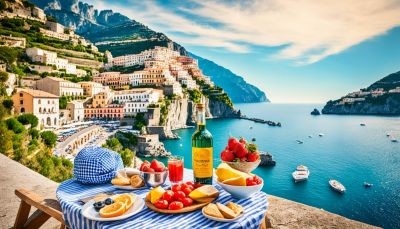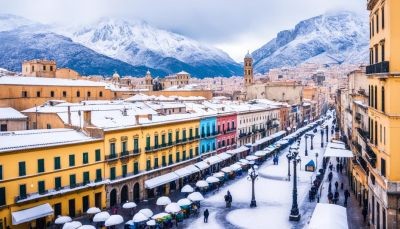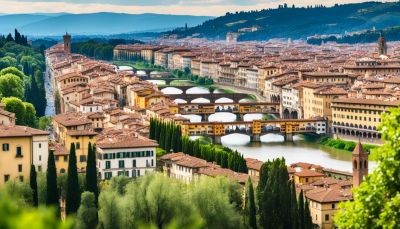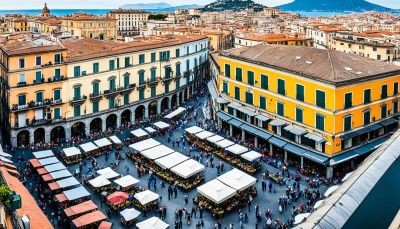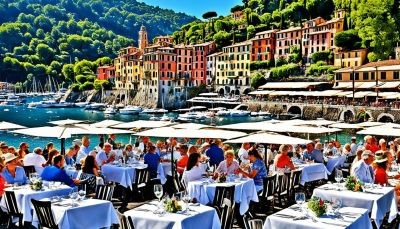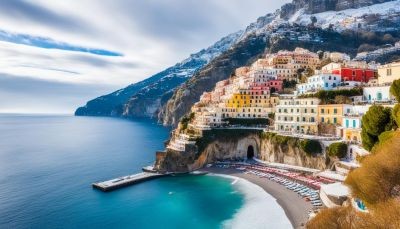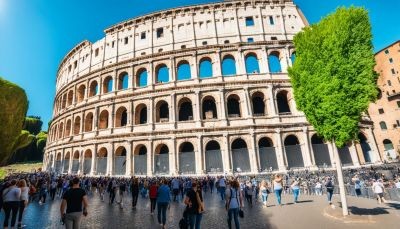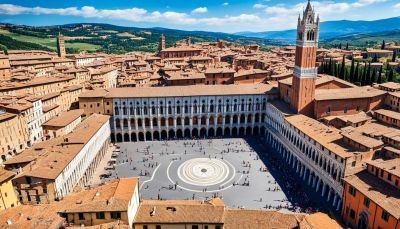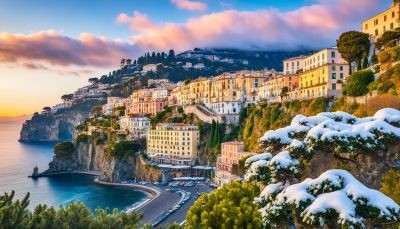Do you dream of seeing Pisa, Italy's historic wonders? Before you go, think about the weather. Pisa sits in the famous Tuscany region. It's not only about the Leaning Tower but also its rich culture. So, when is the best time to explore Pisa and truly enjoy it?
Key Takeaways
- The spring and fall shoulder seasons offer the most mild weather and smaller crowds in Pisa.
- Summer brings warmer temperatures and larger tourist crowds, while winters can be cool and quieter.
- Understanding Pisa's seasonal climate and weather patterns can help you plan a trip that aligns with your travel preferences.
- Explore Pisa's museums, historic sites, and local cuisine at a leisurely pace during the shoulder seasons.
- Pisa serves as an excellent base for day trips to the Cinque Terre, Florence, and the Tuscan countryside.
Exploring Pisa: A Historic Maritime City
Pisa is famous for its Leaning Tower, found in Cathedral Square. This tower lets you see the whole city from the top. Besides the tower, the city is full of museums and historic places, showing its deep culture.The Leaning Tower and Piazza dei Miracoli
The Leaning Tower is Pisa's most known site. It was built over 177 years and leans in a fascinating way. Near the tower, you can visit the Piazza dei Miracoli, a UNESCO site with the Pisa Duomo, the Battistero, and the Campo Santo.Beyond the Leaning Tower: Museums and Historic Sites
Although the Leaning Tower is a must-see, Pisa has more to offer. You can explore the Museo delle Sinopie, the Museo Nazionale di San Matteo, and the Pisa Duomo. They all show beautiful Romanesque and Gothic architecture.Day Trips from Pisa: Cinque Terre, Florence, and Tuscany
Pisa is a great place to stay for discovering Tuscany. The colorful Cinque Terre villages are not far by train. Florence is nearby too, offering museums, galleries, and Renaissance buildings. For a taste of Tuscany's countryside, there are rolling hills, vineyards, and lovely towns to visit.Ideal Weather for Visiting Pisa
The best times to visit Pisa are in the spring and fall. This is when theweather is mild
, and there are fewer people. In spring, you'll find
comfortable temperatures
, often hitting 66°F (19°C). The temperature drops to 46°F (8°C) at night. The
fall season
is similar, with average highs at 72°F (22°C) and lows at 52°F (11°C). These times are great for seeing Pisa's beauty without summer's heat or winter's chill.
Harvest time
in the fall is special. You can try fresh local food, wine, and join in festivals.
Spring: Mild Temperatures and Fewer Crowds
Spring is a wonderful season to explore Pisa. ItsMediterranean climate means mild temperatures. This is perfect for enjoying the city without the big summer crowds. Days are around 66°F (19°C), and nights drop to 46°F (8°C).Fall: Pleasant Weather and Harvest Season
The fall season is not just cooler; it's lovely too. You'll experience highs of 72°F (22°C) and lows of 52°F (11°C). It's very pleasant and cozy. Also, it'sharvest season
. This means you can taste local foods, wines, and enjoy festivals. All of which make your visit more special.
Pisan Cuisine: Fresh Ingredients and Regional Flavors
Pisa blends Tuscan food traditions with its coastal charm. Pisan cuisine shines with fresh, simple ingredients. Olive oil and Tuscan wine are key in many dishes. You'll find seafood, game meats, and special treats like pesto with pine nuts.Traditional Dishes and Desserts
Cacciucco is a top pick, a thick seafood stew. It's packed with different fish and shellfish. Another hit is tortelli di ricotta. These are ravioli filled with creamy ricotta. Try the Pisan dessert torta co' bischeri, a tart with rice, pine nuts, and more.Wine and Cocktails in Tuscany
Though not as famed as other wine areas, Pisa and nearby spots have great wines. In the region, many wineries are open to visits. Don’t forget the famous Negroni cocktail from Florence. It mixes red vermouth, gin, and Campari.Accommodation Options in Pisa
Planning to stay in Pisa offers many accommodation options for all budgets. You can pick from well-known Pisa hotels to small Pisa B&Bs. There's something for every type of traveler.If you prefer more freedom, think about a Pisa vacation rental or an Airbnb. These choices give you a cozy, local feel. You can truly live like the locals do.
When choosing your place to stay, consider how close it is to the Leaning Tower. Also, think about reaching the beautiful Arno River, and the beaches. Take these into account for a smooth visit.
| Accommodation Type | Pros | Cons |
|---|---|---|
| Pisa hotels | Convenient location, amenities, and service | Can be more expensive, especially during peak seasons |
| Pisa B&Bs | Charming, personal atmosphere, often more affordable | Fewer on-site facilities compared to hotels |
| Pisa vacation rentals | More space, privacy, and a "home away from home" feel | Require more self-sufficiency, such as handling check-in/out |
| Pisa Airbnb | Wide variety of options, often more budget-friendly | Quality and amenities can vary greatly between listings |
Getting to and Around Pisa
Pisa is linked well with big cities in Italy and Europe, so reaching it is simple. You can fly, take a train, bus, or rent a car with ease. This offers many ways to travel that fit your plans.By Air: Pisa International Airport
Pisa International Airport, or Galileo Galilei Airport, is the main airport. It serves flights from Italy and Europe, making access easy. After arriving, you can rent a car at the airport or use the PisaMover shuttle to get to the city's heart.By Train, Bus, and Car
You can also get to Pisa from places like Florence, Rome, and Milan by train, bus, or car. The central station, Pisa Centrale, is linked to trains from all over Italy. There are also many buses, both local and long-distance, connecting Pisa to towns in Tuscany. If you want to move freely, renting a car is a great choice. It lets you see Pisa and the beautiful Tuscan countryside at your pace.Local Transportation in Pisa
Getting around Pisa after you arrive is straightforward. It’s great for walking, especially to spots like the Leaning Tower of Pisa and Piazza dei Miracoli since they are close. For farther places, buses and the PisaMover are reliable. You can also rent a car in Pisa to tour the city and its history.Budget-Friendly Tips for Visiting Pisa
Pisa can be a budget-friendly place to visit. Make the most of the city's free sights and things to do. It's a great way to experience this historic Italian spot without overspending.Free Attractions and Activities
Admire the Leaning Tower and the Piazza dei Miracoli from outside. It's free of charge. Enjoy a walk by the Arno River for beautiful views of the city at no cost.Picnicking and Local Markets
Saving on food is easy. Just pack a picnic with items from local Pisa markets, like Mercato delle Vettovaglie. Visiting the local markets also lets you dive into Pisa's culture. You can try local foods, see what's for sale, and enjoy the market's buzz without spending much.Use Pisa's free attractions and activities to your advantage. Enjoy Pisa picnics and shopping in the markets. This way, you can see all of Pisa's charm on a budget.
Pisa, Italy: Best Months for a Weather-Savvy Trip
The top times for a trip to Pisa are in the spring and fall. During these seasons, the weather is nice and the crowds are lighter. You’ll be able to see Pisa's famous spots without the hot, sticky summer or the cold, damp winter vibes.Shoulder Seasons: Spring and Fall
Spring in Pisa has days with highs near 66°F (19°C) and lows at 46°F (8°C). This makes it great for checking out the sights or doing things outdoors. The fall is cool with highs hitting about 72°F (22°C) and lows at 52°F (11°C). These times welcome you to Pisa's rich history and lively lifestyle without the summer's heat.Summer in Pisa: Warm and Crowded
Summers in Pisa can get hot, averaging 86°F (30°C). This is also when the city is the most packed. So, visiting then may mean competing with more tourists. If you prefer a quieter tour, visiting in summer might not be the best choice.Winter in Pisa: Cool and Quieter
Pisa's winters are cool, with highs around 55°F (13°C) and lows at 37°F (3°C). It's not the best for outdoor fun, but you might have the city almost to yourself. With fewer visitors, winter offers a more serene and genuine look at Pisa’s beauty.Tuscany's Diverse Seasons and Climate
Tuscany, known for Pisa, has a variety of weather and seasons. Summers bring heat, with highs near 86°F (30°C). Winters are cooler, with highs around 52°F (11°C) and lows at 37°F (3°C). Spring and fall are lovely times to visit, with mild weather and low humidity.Summer in Tuscany
Tuscany's summer draws over 94 million people annually. They come for the beautiful scenery and history. July is the hottest, with temperatures reaching 86°F (30°C). It's wise to drink water and find shade when it's hot.Fall in Tuscany
In fall, Tuscany is painted with bright colors and feels a bit cooler. Days see highs near 72°F (22°C) and lows at 52°F (11°C). This season is perfect for exploring and celebrating the harvest. Yet, some areas may have heavy storms, causing mudslides and flooding.Winter in Tuscany
The winter in Tuscany can be cold, with highs of 52°F (11°C) and lows at 37°F (3°C). Snow falls in the mountains, mostly in January and February. Despite the cold, it's an ideal time to see Tuscany's cities without the usual crowds.Spring in Tuscany
Spring wakes Tuscany up with mild weather and less humidity. Highs average around 66°F (19°C) and lows at 46°F (8°C). It's a great season for visiting the area's old sites, wineries, and quaint villages. But, March can be cold and windy, and there might be late snowstorms.Planning Your Trip to Pisa
When you plan your trip to Pisa, think about the best weather, crowd sizes, and any special events you want to see. Spring and fall are great times to visit because the weather is nice and there are fewer people. But, if you really want to see something special like the Regatta of the Ancient Maritime Republics, you might have to come in the summer when it's busier.Considerations for Timing Your Visit
Planning ahead and doing your research can make your Pisa visit great, no matter the time of year. Knowing when the weather is best and what events are happening can help you plan your perfect Pisa trip. This way, you get to enjoy this beautiful Italian city to the fullest.Festivals and Events in Pisa
If you want to join in Pisa's festivals and events, check out the city's schedule and plan your visit around them. Pisa has lots of fun traditions, from the lively Regatta of the Ancient Maritime Republics to the dramatic Gioco del Ponte. There's something happening all year round to help you get to know Pisa's culture and history.| Festival | Date | Description |
|---|---|---|
| Regatta of the Ancient Maritime Republics | June | A historic boat race celebrating the sea connections of Pisa and other nearby cities in Italy. |
| Gioco del Ponte | June | A themed battle reenactment over the Arno River with people in costumes and a mock fight. |
| Luminara di San Ranieri | June 16 | It's a yearly celebration where thousands of candles light up the Arno River and the Leaning Tower. |
Conclusion
Pisa, Italy is a captivating destination that offers visitors a wealth of historic sights, cultural experiences, and regional cuisine. By understanding the ideal weather conditions and seasonal factors, you can plan a Pisa trip that aligns with your travel preferences.Whether you choose to visit during the mild spring and fall shoulder seasons or are willing to brave the crowds and warmer temperatures of summer, Pisa's charms are sure to leave a lasting impression.
With careful planning and a weather-savvy approach, you can create an unforgettable Pisa experience.
FAQ
What are the best times to visit Pisa?
It's great to visit Pisa in spring and fall. The weather is nice and the crowds are small. In spring, the temperature is about 66°F (19°C) during the day and 46°F (8°C) at night. Fall has similar temperatures, but a little warmer, around 72°F (22°C) during the day and 52°F (11°C) at night.
What are the main attractions in Pisa beyond the Leaning Tower?
Besides the famous Leaning Tower, Pisa has many more places to visit. There's the Duomo, Campo Santo, and Battistero. You can also take day trips to Cinque Terre, Florence, and Tuscany's beautiful countryside.
What is the weather like in Pisa during the different seasons?
Pisa has a Mediterranean climate. Summers are warm and winters are mild and rainy. Summer sees highs of 86°F (30°C). Winter is cooler, with 55°F (13°C) days and 37°F (3°C) nights. Spring and fall are the best times to visit for mild weather and lower humidity.
What are some traditional Pisan dishes and local specialties?
Pisan food focuses on fresh and simple ingredients. Olive oil and wine are key. You'll find dishes with fish, wild game, and pesto with pine nuts. For dessert, try torta co' bischeri, a tart with rice, nuts, chocolate, and fruit.
What are the best ways to get to and around Pisa?
Getting to Pisa is easy. Pisa International Airport has flights to many cities. You can also come by train, bus, or car from places like Florence and Rome. In Pisa, walking is a good way to get around. Buses and the PisaMover shuttle rail are also available.
How can I visit Pisa on a budget?
Visiting Pisa without spending much is possible. Many sights, like the Leaning Tower, are free to see from the outside. Walking along the Arno River is a nice, cheap activity. Save money by buying food at local markets.
What factors should I consider when planning my trip to Pisa?
Think about the weather, the size of the crowds, and any events you might want to see. Spring and fall are nice for weather and avoiding crowds. But if there's a special event in the summer you want to see, plan accordingly.
